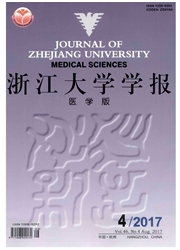

 中文摘要:
中文摘要:
目的:研究缺血后处理(postconditioning)对不同时程冷保存大鼠心脏的作用及其机制。方法:利用Langendorff离体鼠心灌注法,观察大鼠心脏在Celsior液(4C)中保存3h或5h后,在其后复灌60min期间血流动力学的恢复情况,并对复灌期间心律失常严重程度进行定量分析。缺血后处理采用全心停灌30s,复灌30s,循环3次。结果:(1)与3h冷保存对照组相比,大鼠心脏冷保存3h后给予缺血后处理,在多个复灌时间点上可明显降低左室舒张末期压力,而心率、左室发展压、左室最大收缩/舒张速率、冠脉流出量、心率与发展压的乘积等的恢复率在复灌期明显高于3h对照组。心脏冷保存3h后心律失常的发生率在复灌第0~10min时最高,缺血后处理可明显降低心律失常的发生率。(2)在缺血后处理短暂复灌期的K—H灌流液中加入100μmol/L的5-HD(线粒体ATP依赖性钾离子通道的阻断剂),可取消缺血后处理降低左室舒张末期压力,增高心率、左室发展压、左室最大收缩/舒张速率、冠脉流出量、心率与发展压乘积的作用。心律失常评分亦明显高于3h缺血后处理组。(3)大鼠心脏冷保存5h后给予缺血后处理,在复灌期间各项动力学指标以及心律失常评分上与5h冷保存对照组无明显差异。结论:缺血后处理对于3h冷保存的大鼠心脏有显著的保护作用,其作用机制可能是部分通过激活线粒体ATP依赖性钾离子通道起作用,而缺血后处理对于5h冷保存的大鼠心脏并无保护作用。
 英文摘要:
英文摘要:
Objective: To assess the effect of postconditioning on cardiac protection of rat hearts suffered from long-term hypothermic preservation. Methods: The Langendorff model of isolated rat heart was used. After 30 min of stabilization,the hearts were stored in 4 C Celsior solution for 3 or 5 h followed by 60 min of reperfusion. Postconditioning was initiated by 3 cycles of 30 s ischemia followed by 30 s reperfusion at the beginning of subsequent persistent reperfusion. The recovery of cardiac contractile function and arrhythmia score were observed. Results: (1) Compared with control group,postconditioning increased the recovery of heart rate (HR),left ventricular systolic pressure (LVDP),maximal rise/fall rate of ventricular pressure (dP/dtmax) and coronary flow (CF) and rate-pressure product (RPP) during reperfusion after 3 h of hypothermic preservation. However, left ventricular end-diastolic pressure (LVEDP) and the cardiac arrhythmia score during the first 10 min of reperfusion was significantly lower in 3 h postconditioning group than that in 3 h control group. (2) The rat hearts treated by postconditioning with 5-HD(100 μmol/L) abolished the amelioration of contract function induced by postconditioning. And it could also increase the cardiac arrhythmia score. (3) Compared with 5 h control group, the HR, LVDP, dP/dt CF, LVEDP, RPP and the cardiac arrhythmia score were not significantly different in postconditioning treated hearts during reperfusion after 5 h of hypothermic preservation. Conclusion: Postconditioning could provide the cardiac protection on 3 h hypothermic preserved rat hearts,but not on 5 h hypothermic preserved rat hearts. The cardiac protection effect might be partly associated with activation of selective mitochondrial ATP -sensitive potassium channel.
 同期刊论文项目
同期刊论文项目
 同项目期刊论文
同项目期刊论文
 期刊信息
期刊信息
